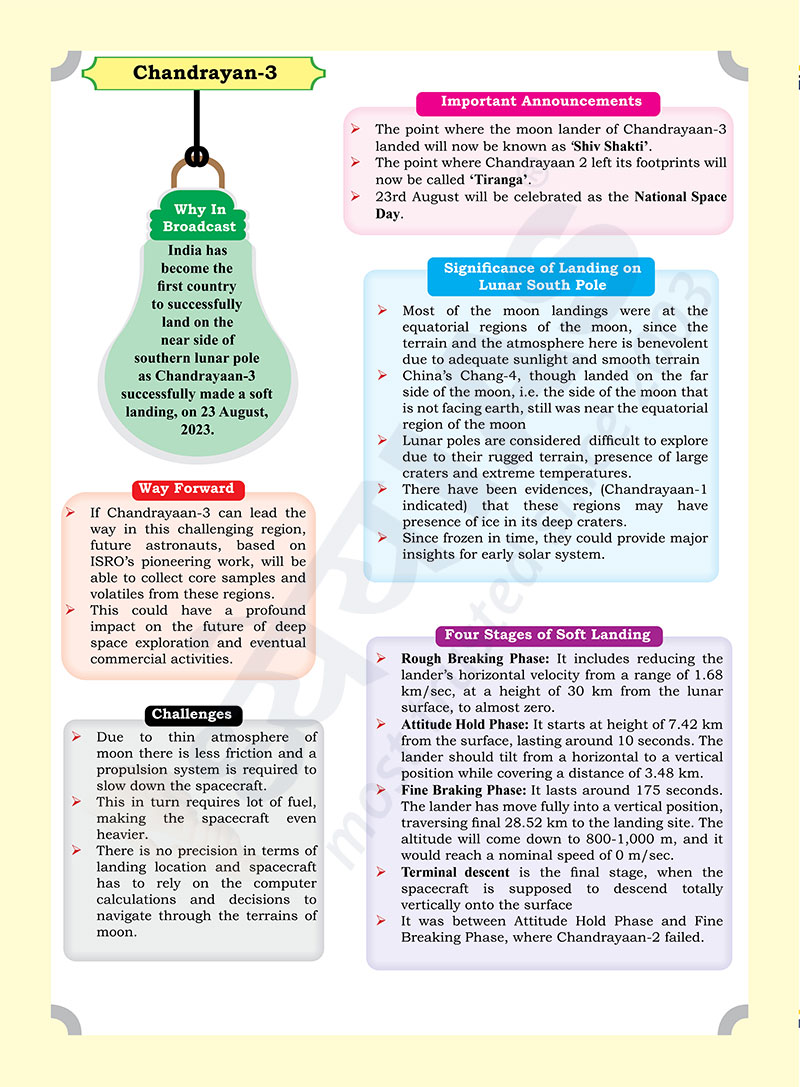Brain-booster /
14 Sep 2023
Brain Booster for UPSC & State PCS Examination (Topic: Chandrayan-3)

Why in Broadcast?
- India has become the first country to successfully land on the near side
of southern lunar pole as Chandrayaan-3 successfully made a soft landing, on
23 August, 2023.
Important Announcements
- The point where the moon lander of Chandrayaan-3 landed will now be
known as ‘Shiv Shakti’.
- The point where Chandrayaan 2 left its footprints will now be called ‘Tiranga’.
- 23rd August will be celebrated as the National Space Day.
Significance of Landing on Lunar South Pole
- Most of the moon landings were at the equatorial regions of the moon,
since the terrain and the atmosphere here is benevolent due to adequate
sunlight and smooth terrain
- China’s Chang-4, though landed on the far side of the moon, i.e. the
side of the moon that is not facing earth, still was near the equatorial
region of the moon
- Lunar poles are considered difficult to explore due to their rugged
terrain, presence of large craters and extreme temperatures.
- There have been evidences, (Chandrayaan-1 indicated) that these regions
may have presence of ice in its deep craters.
- Since frozen in time, they could provide major insights for early solar
system.
Four Stages of Soft Landing
- Rough Breaking Phase: It includes reducing the lander’s
horizontal velocity from a range of 1.68 km/sec, at a height of 30 km from
the lunar surface, to almost zero.
- Attitude Hold Phase: It starts at height of 7.42 km from the
surface, lasting around 10 seconds. The lander should tilt from a horizontal
to a vertical position while covering a distance of 3.48 km.
- Fine Braking Phase: It lasts around 175 seconds. The lander has
move fully into a vertical position, traversing final 28.52 km to the
landing site. The altitude will come down to 800-1,000 m, and it would reach
a nominal speed of 0 m/sec.
- Terminal descent is the final stage, when the spacecraft is supposed to
descend totally vertically onto the surface
- It was between Attitude Hold Phase and Fine Breaking Phase, where
Chandrayaan-2 failed.
Challenges
- Due to thin atmosphere of moon there is less friction and a propulsion
system is required to slow down the spacecraft.
- This in turn requires lot of fuel, making the spacecraft even heavier.
- There is no precision in terms of landing location and spacecraft has to
rely on the computer calculations and decisions to navigate through the
terrains of moon.
Way Forward
- If Chandrayaan-3 can lead the way in this challenging region, future
astronauts, based on ISRO’s pioneering work, will be able to collect core
samples and volatiles from these regions.
- This could have a profound impact on the future of deep space
exploration and eventual commercial activities.







